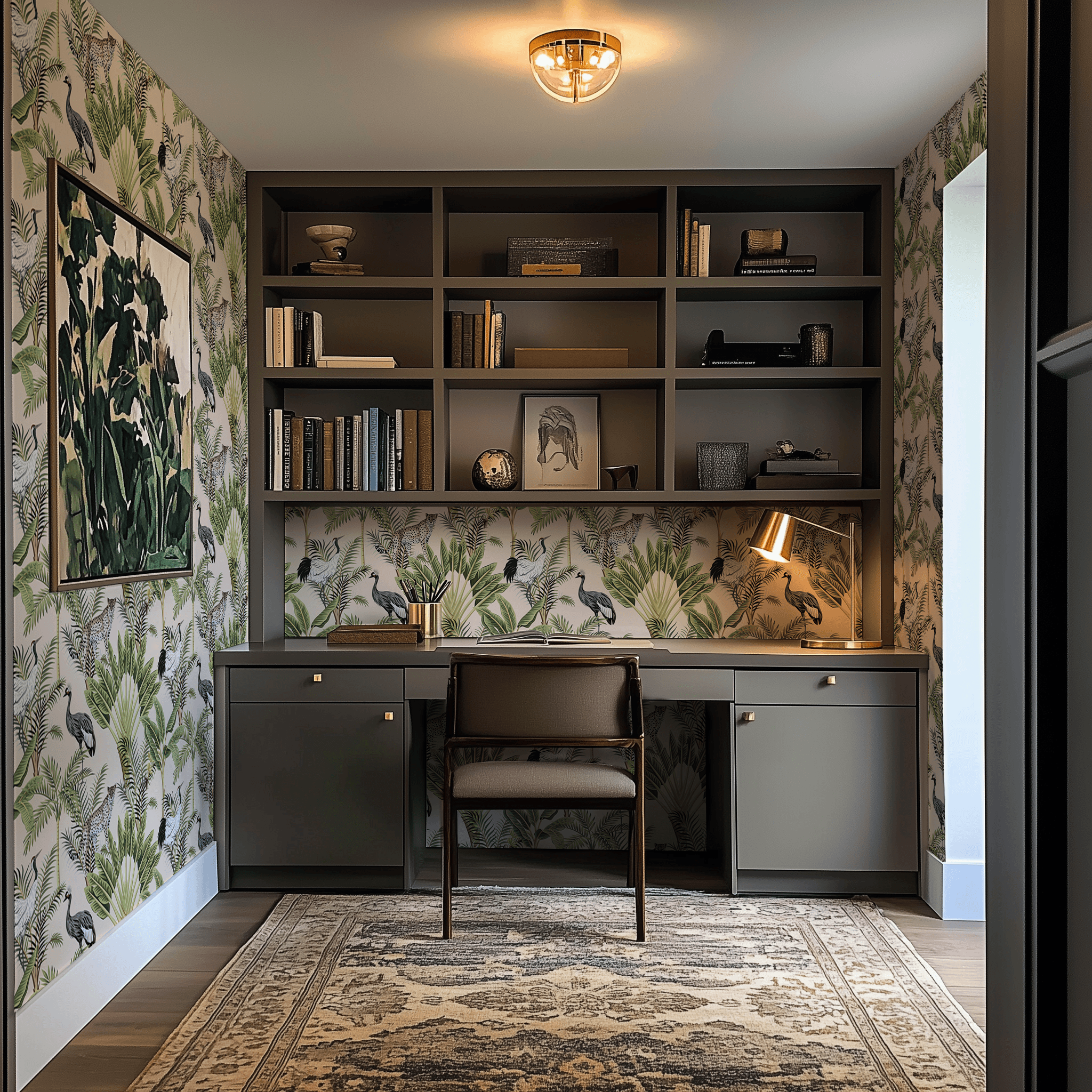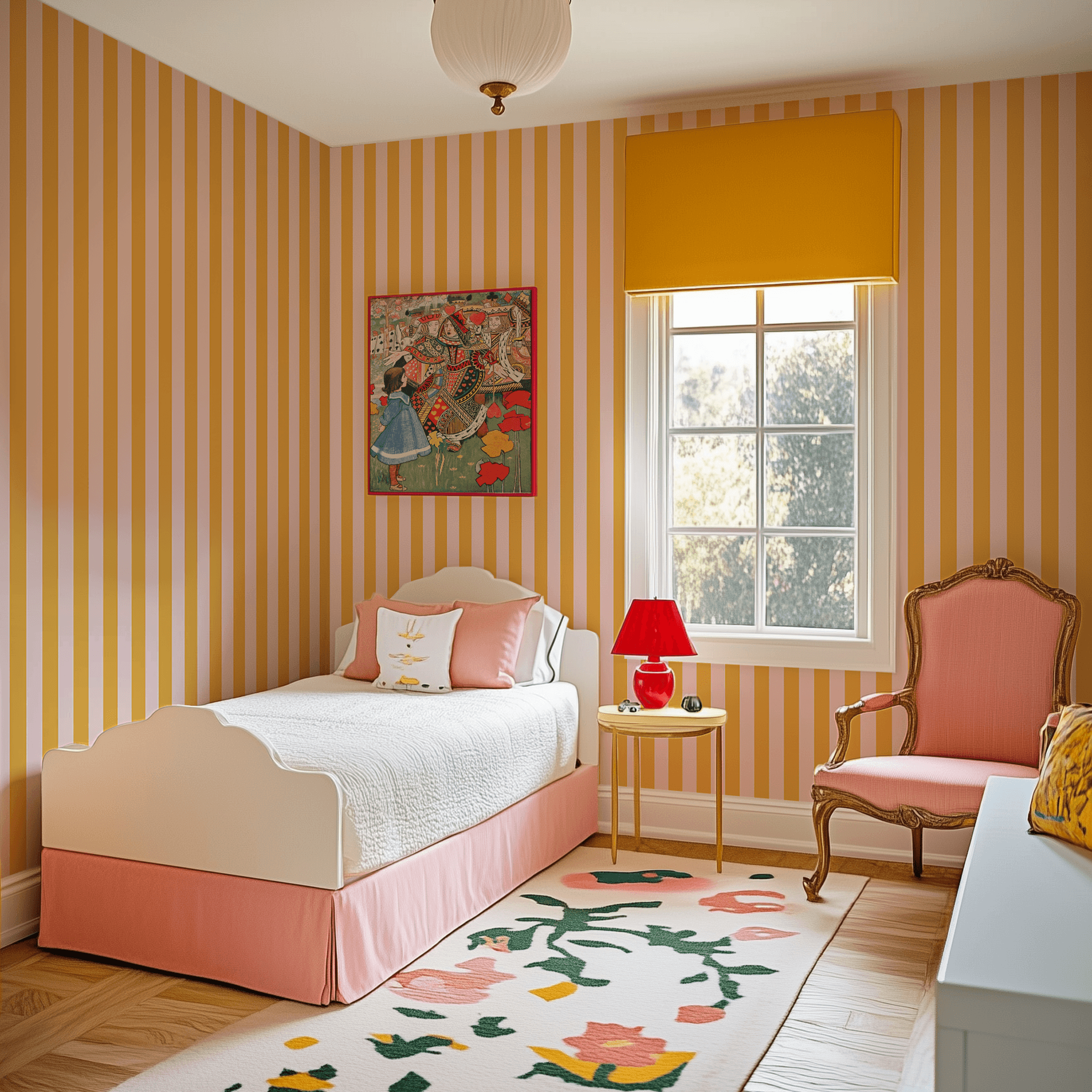
Can You Install Wallpaper Over Wallpaper?
Can New Wallpaper Be Installed Over Old Wallpaper?
Wallpaper can usually be applied over existing wallpaper, but factors like wallpaper type, adhesion, texture, and condition of the old wallpaper must be considered. Proper surface preparation ensures a smooth application and longevity of the new wallpaper.
Explore our article for key considerations before deciding to wallpaper over your existing one. Discover the advantages of Huggleberry Hill's peel-and-stick wallpaper, which is ideal for concealing the old layers. Meanwhile, our step-by-step guide ensures a smooth process—from prepping the surface to applying the new wallpaper. Whether you're a seasoned decorator or a first-timer, we've got you covered.
Factors to Consider When Wallpapering Over Old Wallpaper
1. How Many Layers Of Old Wallpaper Are There?
When considering wallpapering over existing wallpaper in a purchased or rented home, it's crucial to investigate the wall's history. Existing layers could harbor mold and bacteria, jeopardizing both health and the durability of your DIY project.
Before proceeding, carefully inspect inconspicuous areas for multiple layers. Use a utility knife to make a small incision, revealing potential hidden complexities. By systematically checking and addressing any existing layers, you ensure a safer and more robust foundation for your wallpapering endeavors, promoting a longer-lasting and healthier living space

2. What Coating Did The Old Wallpaper Have?
Wallpapering over different wallpaper surfaces depends on material types. Breathable wallpaper, such as paper and fabric woven types, offer a smoother base, facilitating easier application of new wallpaper over top. Their porous nature allows for better adhesion.
In contrast, shiny non-woven wallpapers such as vinyl, with a more rigid and less permeable texture, pose challenges. These types resists moisture and can prevent proper adhesion. To check if the existing wallpaper is woven or non-woven, dampen a small section - if it darkens then it is most likely woven.

3. What’s The Condition Of The Old Wallpaper?
When wallpapering over old wallpaper, a smooth surface, ree from bumps and cracks, is always recommended. Uneven textures can compromise the adhesion and appearance of the new wallpaper. Ideally, choose a thicker wallpaper, as it helps conceal minor imperfections on the underlying surface, creating a smoother finish. This approach not only enhances the aesthetic outcome but also ensures a more forgiving application process, and better adhesion of the new wallpaper.

4. What’s The Condition Of The Wall Beneath The Wallpaper?
Thoroughly examining the wall under existing wallpaper before starting a new project is essential. The existing wallpaper might have been used to mask underlying imperfections or damage. Investigating ensures you address any issues like cracks, moisture damage, or uneven surfaces, preventing these hidden flaws from surfacing later.
Uncovering any issues and fixing them beforehand guarantees a more stable foundation for your new wallpaper, enhancing its longevity and maintaining a pristine appearance over time.

5. What’s The Color Of The Old Wallpaper?
When applying new wallpaper over existing wallpaper, be clever with color choices. Bold or dark colors beneath lighter wallpaper may not stack well, potentially showing through.
For instance, a vibrant red or deep blue under a light, pastel hue might cause visibility issues. Opting for a thicker new wallpaper can mitigate this concern, providing better coverage and minimizing the risk of underlying colors affecting the final aesthetic.

Can Huggleberry Hill’s Peel & Stick Wallpaper Be Installed Over Old Wallpaper?
Huggleberry Hill's peel-and-stick wallpaper can be the right solution for concealing old wallpaper due to several key attributes.
-
Thick: Its thick, luxurious fabric finish not only adds a touch of elegance but also excels in camouflaging slight imperfections on the underlying surface, providing a smooth and flawless appearance.
-
Breathable: The wallpaper's woven texture promotes breathability, preventing moisture accumulation and safeguarding against mold, ensuring a healthy environment.
-
Lightweight: Additionally, its lightweight nature means it adheres securely without pulling on the surface underneath, guaranteeing longevity and a consistently well-maintained aesthetic.
-
Excellent Adhesion: The high quality adhesive is formulated to provide a strong bond, ensuring the wallpaper adheres securely to various surfaces including old paper or woven wallpaper.
- Rich inks: It is printed with high-pigment inks, ensuring that the new design is vibrant, ideal for covering an underlying pattern or color effectively.
How To Install Wallpaper Over Wallpaper
Materials & Prep Work
Ideally the installation of new wallpaper should be over paper or woven wallpapers that are in excellent condition, devoid of any visible signs of damage or underlying wall issues. This recommendation is crucial to ensure a smooth and successful application.
- Sharp Cutting Blade: Ensures clean and accurate cuts for any necessary adjustments.
- Tape Measure or Laser Level: Essential for precise measurements and ensuring the wallpaper is applied straight and level.
- Wallpaper Smoother or Squeegee: Facilitates the removal of air bubbles and creases during application, ensuring a smooth and even finish.
- Straight Edge or Metal Ruler: Provides a guide for precise cutting, especially in areas that require careful attention to detail, such as outlets or uneven ceilings.
- Ladder: For access to higher parts of the wall where installation should begin
- Clean and Dry Hands: Essential for handling the wallpaper without leaving smudges
The Process
This user-friendly step-by-step will help you to confidently install Huggleberry Hill's wallpaper over your old one:
-
Find a Level Starting Point:
Identify a level spot on your wall to ensure straight and aligned wallpaper application.
-
Peel Off the Backing:
Begin by peeling approximately 10 inches (20 centimeters) of the paper backing from the top of the wallpaper panel.
-
Apply to the Wall:
Place the wallpaper at the top of the wall on the level spot. Smooth it down gradually in 10-inch (20-centimeter) sections, peeling off more backing as you go to prevent air bubbles and allow repositioning within 24 hours if necessary.
-
Smooth Out Bubbles:
Use a wallpaper smoother to achieve a smooth finish and eliminate any air bubbles.
-
Add the Next Panel:
Unlike traditional wallpaper, peel-and-stick wallpaper doesn't require overlapping. Place the second panel alongside the edge of the first one, not on top of it.
-
Repeat the Process:
Continue steps 1-5 until the entire wall is covered.
-
Trim Excess Material:
After all panels are in place, trim any extra material at the bottom of each panel for a level appearance. Cut around light switches and sockets as needed.
-
Final Smoothing:
Ensure a secure bond by using a clean, soft cloth to give the wallpaper a final smoothing. Repeat this process after 2 days and again after 2 weeks to ensure long-lasting adhesion.


